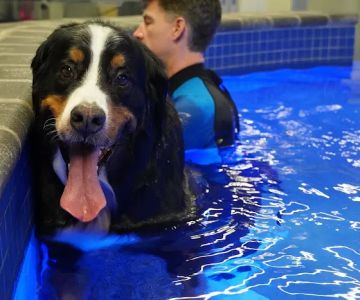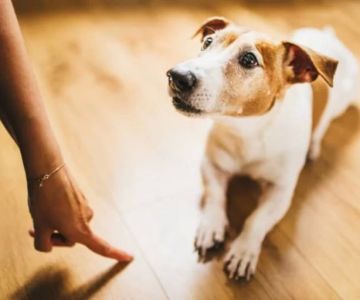- 1-understanding-why-dogs-get-excited-when-guests-arrive
- 2-signs-your-dog-needs-calmness-training
- 3-preparing-your-home-and-dog-before-guests-visit
- 4-step-by-step-training-techniques-to-promote-calm-behavior
- 5-real-examples-of-successful-calmness-training
- 6-common-mistakes-to-avoid-during-training
- 7-how-hidden-brook-veterinary-can-support-your-dogs-behavior-training
1. Understanding Why Dogs Get Excited When Guests Arrive
Every dog owner knows the moment — the doorbell rings, and suddenly, it’s chaos. Your friendly pup turns into a whirlwind of barking, jumping, and tail-wagging excitement. But before frustration sets in, it’s worth asking why this happens. Dogs are social animals, and visitors represent new smells, voices, and energy. For many dogs, guests trigger instinctive curiosity and protective behavior at the same time.
Understanding your dog’s emotional state is the first step in learning how to train dogs to be calm when guests arrive. Often, excitement is a mixture of happiness, territorial alertness, and uncertainty. By addressing the root cause rather than the surface behavior, you can guide your dog to associate guests with calm and positive experiences rather than chaos and overstimulation.
2. Signs Your Dog Needs Calmness Training
Some dogs are naturally composed, while others treat every visitor like a long-lost friend—or potential intruder. If your dog barks excessively, jumps on guests, spins in circles, or whines at the sound of the doorbell, it’s time to start structured training. These are signs your dog doesn’t yet know how to regulate excitement or handle social changes in the home environment.
It’s also common for dogs to exhibit anxiety-based behaviors—like pacing, hiding, or clinginess—when new people enter. Calmness training isn’t just about manners; it’s also about helping your dog feel safe and confident. With the right approach, even reactive or nervous dogs can learn to greet visitors politely.
3. Preparing Your Home and Dog Before Guests Visit
Preparation makes all the difference. Before guests arrive, take your dog for a brisk walk to burn off excess energy. A tired dog is naturally calmer. Make sure to remove or secure distractions—like squeaky toys—and prepare a quiet space such as a crate, dog bed, or designated mat where your dog can retreat if overstimulated.
It’s also helpful to use a consistent routine before the doorbell rings. For example, teach your dog that when the doorbell sounds, it means “go to your spot.” Reward them for calmness with treats or praise. Over time, they’ll begin to associate the sound of guests arriving with a predictable, calm routine instead of uncontrolled excitement.
4. Step-by-Step Training Techniques to Promote Calm Behavior
Teaching a dog to remain calm when guests arrive involves repetition, timing, and positive reinforcement. Here’s a breakdown of proven techniques that behavior experts recommend.
1. Desensitize the Doorbell and Entry Sounds
Start by recreating the sound of a doorbell or knocking while rewarding your dog for staying calm. Practice this daily until your dog can hear the sound without reacting. Gradually increase the realism by involving a family member to ring the bell from outside.
2. Teach the “Go to Your Spot” Command
Choose a mat or area near the entrance and train your dog to go there on cue. Begin indoors without distractions, and reward your dog for lying down or sitting quietly on their spot. As training progresses, combine this with the doorbell exercise until your dog automatically moves to their spot when someone arrives.
3. Reward Calm, Ignore Excitement
Dogs thrive on attention—positive or negative. If your dog jumps or barks when guests enter, avoid yelling or physically pushing them away. Instead, ignore the behavior completely and reward them when they sit or relax. This teaches them that calmness earns praise while excitement leads to no reward.
4. Gradually Introduce Real Guests
Once your dog has mastered practice sessions, invite a patient friend to act as a real guest. Keep sessions short and structured. Use treats, calm body language, and clear cues. Over time, increase the duration and unpredictability of visits until your dog can remain composed even during spontaneous arrivals.
5. Real Examples of Successful Calmness Training
Take the story of Bella, a young Labrador who would leap on guests the moment the door opened. Her owner, Rachel, worked with a professional trainer for two weeks, following a structured “go to mat” routine. By week three, Bella would calmly sit at her spot, tail wagging but under control. Her owner described it as “a complete transformation.”
Another example is Max, a rescue terrier with severe anxiety around strangers. His owner began slow exposure sessions combined with relaxation training. Over time, Max learned that visitors meant treats, playtime, and calm interaction—not fear or chaos. These stories prove that with patience and consistency, any dog can learn to behave calmly when guests arrive.
6. Common Mistakes to Avoid During Training
One of the biggest mistakes owners make is expecting instant results. Dogs learn through repetition and consistent signals. If you let your dog greet one visitor excitedly but expect calmness the next time, the inconsistency will confuse them. Stick to your training routine every single time, even with family or delivery drivers.
Another common error is using punishment-based methods. Yelling, leash jerking, or isolating your dog for misbehavior can increase stress and worsen reactivity. Instead, focus on positive reinforcement—rewarding calm behavior and patiently redirecting unwanted actions. The goal is to teach your dog what to do, not just what not to do.
7. How Hidden Brook Veterinary Can Support Your Dog’s Behavior Training
At Hidden Brook Veterinary, we know that a calm, well-behaved dog makes life easier for everyone. Our veterinary behavior experts provide professional advice on anxiety management, training strategies, and health-related causes of hyperactivity. Sometimes, excitement or aggression during guest visits may stem from underlying issues such as thyroid imbalance or lack of mental stimulation—factors we can help identify and treat.
We also offer personalized consultations and recommend trusted training products that promote calmness, from pheromone diffusers to anxiety wraps. With our holistic approach, your dog’s emotional health and physical well-being go hand in hand. Whether your pet is a playful puppy or a reactive rescue, Hidden Brook Veterinary can guide you toward a happier, calmer home environment.
Training your dog to stay calm when guests arrive takes time, patience, and the right techniques—but the payoff is worth it. A relaxed dog creates a peaceful home and makes every visitor feel welcome. With expert support and consistent training, even the most excitable pup can become the perfect host’s companion.











